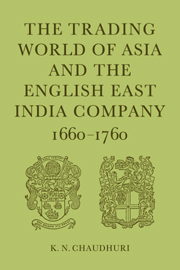Book contents
- Frontmatter
- Contents
- Tables
- Figures
- Maps
- Abbreviations
- Notes on dates, contemporaneous spellings, currency, and weights
- Preface
- Acknowledgements
- 1 The international economy and the East India trade
- 2 A formal theoretical model of the East India Company's trade
- 3 The structure of early trade and the pattern of commercial settlements in Asia
- 4 The evolution of the Company's trading system: operation and policy 1660–1760
- 5 Long-term trends and fluctuations 1660–1760
- 6 Politics of trade
- 7 Markets, merchants, and the Company
- 8 The export of treasure and the monetary system
- 9 The structure of country trade in Asia
- 10 Export of European commodities
- 11 The Company and the Indian textile industry
- 12 The Company's trade in textiles
- 13 Pepper
- 14 Import of bulk goods
- 15 Raw silk
- 16 Coffee
- 17 Imports from China
- 18 Financial results
- 19 Conclusion
- APPENDICES
- General glossary
- Bibliography
- Short titles cited in the reference notes
- Notes
- Index
7 - Markets, merchants, and the Company
Published online by Cambridge University Press: 06 July 2010
- Frontmatter
- Contents
- Tables
- Figures
- Maps
- Abbreviations
- Notes on dates, contemporaneous spellings, currency, and weights
- Preface
- Acknowledgements
- 1 The international economy and the East India trade
- 2 A formal theoretical model of the East India Company's trade
- 3 The structure of early trade and the pattern of commercial settlements in Asia
- 4 The evolution of the Company's trading system: operation and policy 1660–1760
- 5 Long-term trends and fluctuations 1660–1760
- 6 Politics of trade
- 7 Markets, merchants, and the Company
- 8 The export of treasure and the monetary system
- 9 The structure of country trade in Asia
- 10 Export of European commodities
- 11 The Company and the Indian textile industry
- 12 The Company's trade in textiles
- 13 Pepper
- 14 Import of bulk goods
- 15 Raw silk
- 16 Coffee
- 17 Imports from China
- 18 Financial results
- 19 Conclusion
- APPENDICES
- General glossary
- Bibliography
- Short titles cited in the reference notes
- Notes
- Index
Summary
The structure of the selling market
The existence of any kind of interregional or international trade subsumes the existence of two separate markets, distinct from each other in space and concept. The structure and organisation of buying and selling markets need not be similar for trade to take place, and in fact all through history they have differed widely from one society to another without impeding the free flow of goods and services between them. However, such differences demand considerable flexibility in commercial techniques on the part of merchants and traders who stand as the vital connecting link in the chain of economic transactions from the producers to the final consumers. The unique quality of English and Dutch trade with Asia, as conducted through joint-stock companies, sprang from the attempt to impose a centralised and bureaucratically directed system of exchange and distribution on markets that were traditionally decentralised, fragmented, and oriented towards individual efforts. This generalisation applies as much to the selling markets in Europe as to the Asian purchasing markets, though on the selling side the chartered companies successfully developed a marketing arrangement that greatly simplified the decision-making process and the complex calculation of risks and uncertainty associated with early modern trade. From the very beginning of their commercial relations with Asia, both the Dutch and English East India Companies made surprisingly little effort to reach the consuming markets directly. The distribution of the imports which provided the bulk of corporate profits was left either to the individual members of the companies or to wholesale specialist dealers.
- Type
- Chapter
- Information
- The Trading World of Asia and the English East India Company1660-1760, pp. 131 - 152Publisher: Cambridge University PressPrint publication year: 1978



